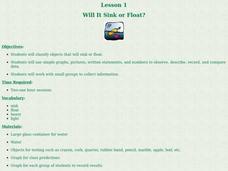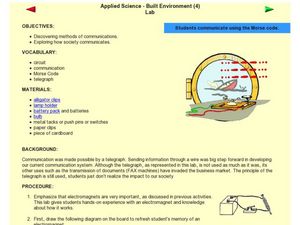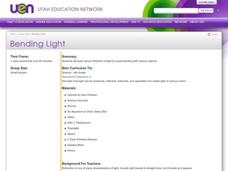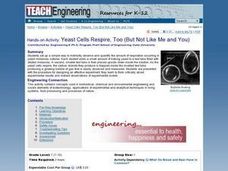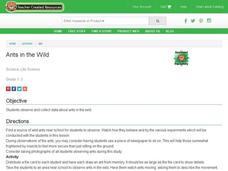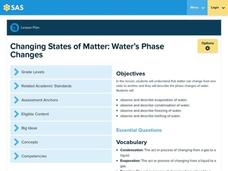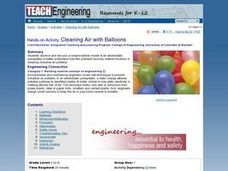Curated OER
Air Pressure
Students perform experiments that demonstrate the characteristics of air pressure. In this physics lesson, students participate and observe experiments using simple household items. The results of these experiments are used to help the...
Curated OER
Will It Sink or Float?
Students perform experiments to see if items will sink or float. In this sink or float lesson, students work in groups to make predictions, and record the results. After the experiments are complete students make a book of the results.
Curated OER
Hidden Animals
Students predict the safest seashore substrate for animals. For this animal habitat experiment, students predict, test their hypothesis, and record data about how wave shocks affect animals living on either sand, gravel or rock.
Curated OER
Communication Methods
Students explore communications by participating in a science class activity. In this communication technology lesson plan, students discuss the process of morse code, its history, and the electromagnets used to create the device....
Curated OER
Bending Light
Sixth graders read Hatchet by Gary Paulsen, discuss refraction, identify example of it from novel, and perform classroom experiments demonstrating refraction and reflection.
Curated OER
TE Activity: Yeast Cells Respire, Too (But Not Like Me and You)
Student observe and quantify the respiration that occurs in yeast-molasses cultures. They complete an effective experiment in order to examine how to think critically about the results.
Curated OER
What Turns Seeds On?
Learners design, implement, and report a scientific research project using the scientific method. They explain the experiment and its findings through poster, essay , or other presentation method.
Curated OER
Chemical Changes
Fourth graders examine and identify chemical and physical changes in a variety of substances. They observe a vinegar and baking soda demonstration, and a water, laundry detergent, and Epsom salt mixture demonstration. They discuss the...
Curated OER
Chances Are
Students are involved in activities that give them experiences predictingthe likelihood of certain events occurring. They become aware that certain outcomes are equally likely, more likely,or less likely than others to occur. Students...
Curated OER
How Trees Contribute to the Water Cycle
In this water cycle instructional activity, 3rd graders conduct an experiment where they observe and calculate how water transpires in different types of trees. Students engage in a class discussion and use Venn Diagrams to compare...
Curated OER
BOWEN'S REACTION SERIES
Learners research Bowen's Reaction Series and recreate the process in an experiment which details the crystallization sequence of minerals that can be observed in nature.
Alabama Learning Exchange
Levers - Weight Lifters
Students investigate how levers help to lift heavy loads. They view and discuss examples of levers, explore various websites, experiment with the levers brought to the class, and watch the video for the book "Mike Mulligan and His Steam...
Curated OER
The Universe
Students describe what scientists mean by an "expanding universe" in their own words. They explain how scientists comprehend the universie is expanding. Students comprehend the vast scale of the universe. They comprehend how theory...
Curated OER
Ants in the Wild
Young scholars investigate ants in the wild. In this insect instructional activity, students observe ant colonies and conduct experiments, such as putting food in the ants' path. Young scholars record their observations.
Curated OER
What's the Matter? (Grade 3)
Third graders organize information about the three types of matter and to reinforce concepts learned in the matter unit of the science curriculum. They use Inspiration software to create a concept map of the three types of matter.
Curated OER
Fizzy Pop
Fifth graders compare and identify variables that affect the rate of a chemical change using Alka-Seltzer, water, ice, and hot water. They time how long each variable takes to pop the canister into the air, and record the results on a...
Curated OER
Electricity
Fourth graders experiment to find out how to light a bulb with simple materials. They make predictions if a light bulb set-up could work and gain knowledge to tell the difference between an open and closed circuit. They also figure out...
Curated OER
Prokaryote Coloring
In this prokaryote worksheet, students answer ten questions about prokaryote cells and they color a diagram of a simple bacteria cell and its structures.
Institute of Electrical and Electronics Engineers
Series and Parallel Circuits
Learners demonstrate simple circuits and find the differences between parallel and serial circuits. In this electronic lesson plan students work in teams to test different designs using a low voltage light bulb.
Curated OER
An Oceanographic Proxy
Students conduct experiments on a sample of sea water. In this oceanography lesson, students inquire how conductivity is used to approximate the salinity ocean water. Students construct their own conductivity meters and test solutions...
Pennsylvania Department of Education
Changing States of Matter: Water’s Phase Changes
Third graders observe the properties of water and in its different states. For this states of matter lesson, 3rd graders view a video, read The Magic School Bus at the Waterworks and experiment with freezing, melting and boiling water to...
Curated OER
Cleaning Air with Balloons
Students examine how a pollutant recovery method functions in cleaning industrial air pollution. They listen to a teacher-led discussion, conduct an experiment with balloons, static electricity, and pepper, and observe and record the...
Curated OER
Hello Sun, Goodnight Moon
Students become familiar with different times around the world through the reading of 9 O'clock Lullaby. In this Earth, sun, moon lesson, students recognize the movement of the Earth and the relationship to the sun and the moon. ...
Curated OER
Characteristics of Living Things
Student use the scientific method to experiment with worms. In this characteristics of living things lesson, students predict and examine the reactions of worms to dry and wet soil. Students share their findings.



